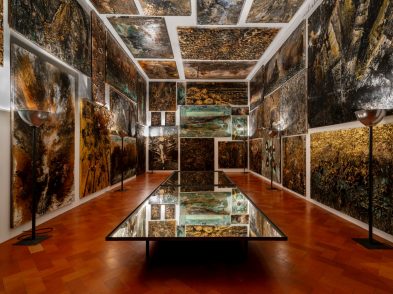In a city much loved by artists, musicians, writers and all those with a creative heartbeat, it is no surprise that Oscar Wilde (1854–1900) was as passionate and enthusiastic about Florence as are most.
Aged 20 and studying at the University of Oxford in 1875, Wilde took a summer vacation to Italy, joined by his ex-professor of Greek at Trinity College, Dublin, Rev. John Pentland Mahaffy, and his friend, William Goulding. Their tour took in Florence, Bologna, Padua, Verona, Milan and Venice, but it was the first of these that Wilde found most difficult to leave. His brief time spent here resulted in a literary output which is little reflected upon but elegantly embodies the Florentine soul. Two such poems are ‘By the Arno’ and ‘San Miniato’, which both create the 19th-century ambience in the Renaissance city, as well as reflecting on its more ancient origins.
‘By the Arno’ settles us into the seemingly idyllic images of the immaculate freshness of a dew-covered valley, the innocent and heart-stirring song of a nightingale with blossoms overheard, crimson in the dawn light while leaves gently blow in the breeze. But it’s not going to last. Wilde mesmerizes the viewer into the false belief that beauty might be eternal, yet transience and the fact that nothing lasts forever is our warning not to take it for granted and to cherish that beauty in the here and now. Wilde wrote satirically elsewhere about the Victorian “manic urge to antithesis” as Declan Kiberd terms it, the gross over-simplification of hollow notions. Wilde resisted these binary notions, hence the gray areas in this poem. Nothing is too beautiful and nothing is too ugly. Equally, we are prompted not to indulge idealized perceptions of Florence, and instead to appreciate the good where and when it can be found.
By the Arno
The oleander on the wall
Grows crimson in the dawning light,
Though the gray shadows of the night
Lie yet on Florence like a pall.
The dew is bright upon the hill,
And bright the blossoms overhead,
But ah! the grasshoppers have fled,
The little Attic song is still.
Only the leaves are gently stirred
By the soft breathing of the gale,
And in the almond-scented vale
The lonely nightingale is heard
The day will make thee silent soon,
O nightingale sing on for love!
While yet upon the shadowy grove
Splinter the arrows of the moon.
Before across the silent lawn
In sea-green mist the morning steals,
And to love’s frightened eyes reveals
The long white fingers of the dawn.
Fast climbing up the eastern sky,
To grasp and slay the shuddering night,
All careless of my heart’s delight,
Or if the nightingale should die.
Another work Wilde wrote while in Florence takes us up into the hills to the basilica of San Miniato al Monte. First published in the Dublin University Magazine in 1876, the poem titled ‘San Miniato’ is almost prayer-like in its homage to the “Angel Painter”, Wilde’s epithet for the Italian painter and Dominican friar Fra Angelico, who is perhaps most famous for his frescoes at San Marco. Wilde’s rapturous emotional response upon his visit to San Miniato is expressed via numerous exclamation marks and the repetition of an exclamatory ‘O!’ that punctuates the poem.
San Miniato
See, I have climbed the mountain side
Up to this holy house of God,
Where once that Angel-Painter trod
Who saw the heavens opened wide,
And throned upon the crescent moon
The Virginal white Queen of Grace,–
Mary! could I but see thy face
Death could not come at all too soon.
O crowned by God with thorns and pain!
Mother of Christ! O mystic wife!
My heart is weary of this life
And over-sad to sing again.
O crowned by God with love and flame!
O crowned by Christ the Holy One!
O listen ere the searching sun
Show to the world my sin and shame.
Poetry wasn’t the only outlet Wilde sought out for his Florentine fantasies: an unfinished play titled ‘A Florentine Tragedy’ is a drama in blank verse found in the form of a manuscript after his death. Set in the Renaissance past, Wilde explores the Medici and the socio-political tensions in 16th-century Florence, where duels, adultery and fatal games would have undoubtedly thrilled audiences. However, ‘A Florentine Tragedy’ did manage to make the stage in Florence when it was performed back in 2009 at Palazzo Davanzati by the B-15 Arts and Media UK company, in collaboration with Syracuse University in Florence, New York University and The British Institute of Florence.
Letters divulge more of Wilde’s thoughts while touring the city. He wrote to his father upon visiting the basilica of San Lorenzo, where he was struck by the “classic Florentine style” construction, the “long nave supported by Greek columns” and the two Medici chapels, calling them “magnificent, very high and octagonal”.
A trip to the Etruscan Museum was defined “Very Interesting” before describing his dinner in a restaurant near San Miniato, with the fresh air of the evening and his walk back home past Palazzo Pitti. He left the city “with much regret”, as he told his mother Lady Wilde, and inevitably we are left to ponder what other works might have emerged had he spent more time here.
Oscar Wilde, dramatist, poet, celebrity and excellent Italian tour guide, grants us glimpses into the marvels of the Italian landscape, history and culture in many other works based in other parts of Italy, but these are his Florentine fragments, which we can treasure.








